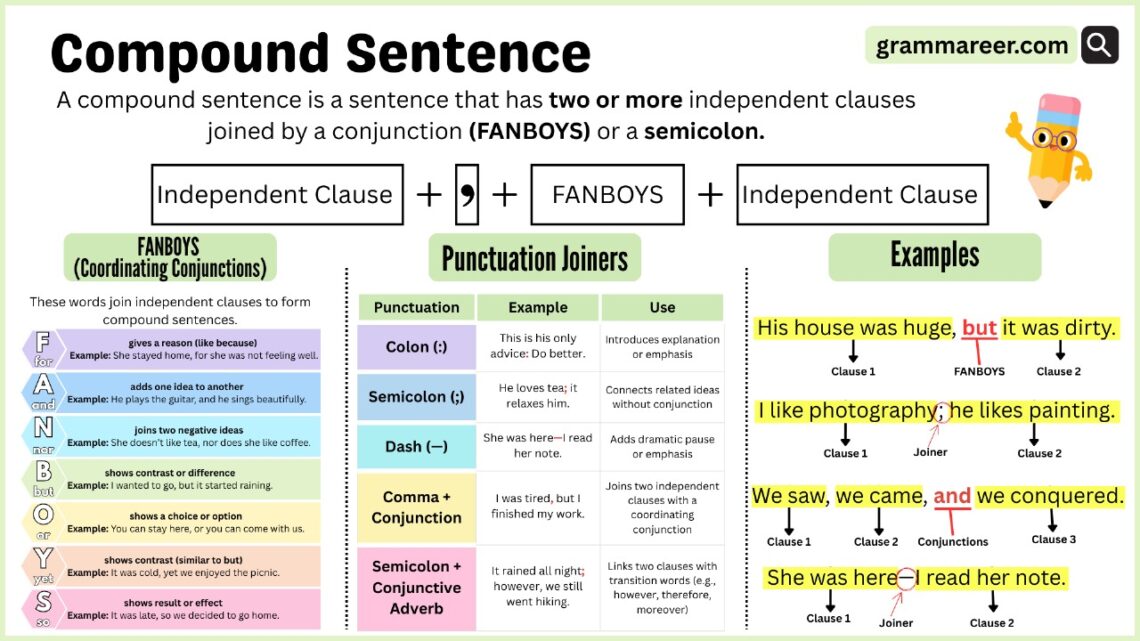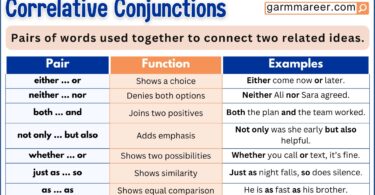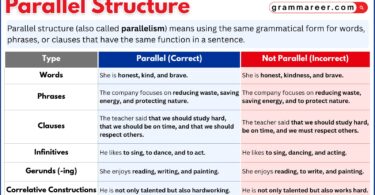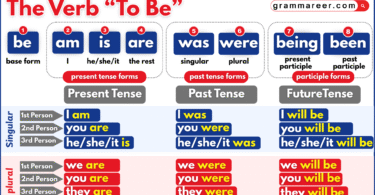Compound sentences – do you know what they are? After learning about simple and complex sentences, the next step is understanding how compound sentences work. These sentences join two or more independent clauses to present related ideas in a clear and balanced way.
In this article, you will explore the full definition of compound sentence, their meaning, structure, and rules for correct usage, along with examples to make the concept easy to undersatnd.
Table of Contents
What Is a Compound Sentence?
A compound sentence is made up of two or more independent clauses joined by a coordinating conjunction. Such sentences can make your writing appear more polished, sophisticated, and informative. Let’s review how different dictionaries define a compound sentence for a clearer understanding.
Definition of Compound Sentence
According to the Oxford Learner’s Dictionary, it is a sentence containing two or more main clauses, usually joined by a conjunction such as and, but, or or. The Cambridge Dictionary describes it as a sentence consisting of two or more independent clauses connected with a coordinating conjunction.
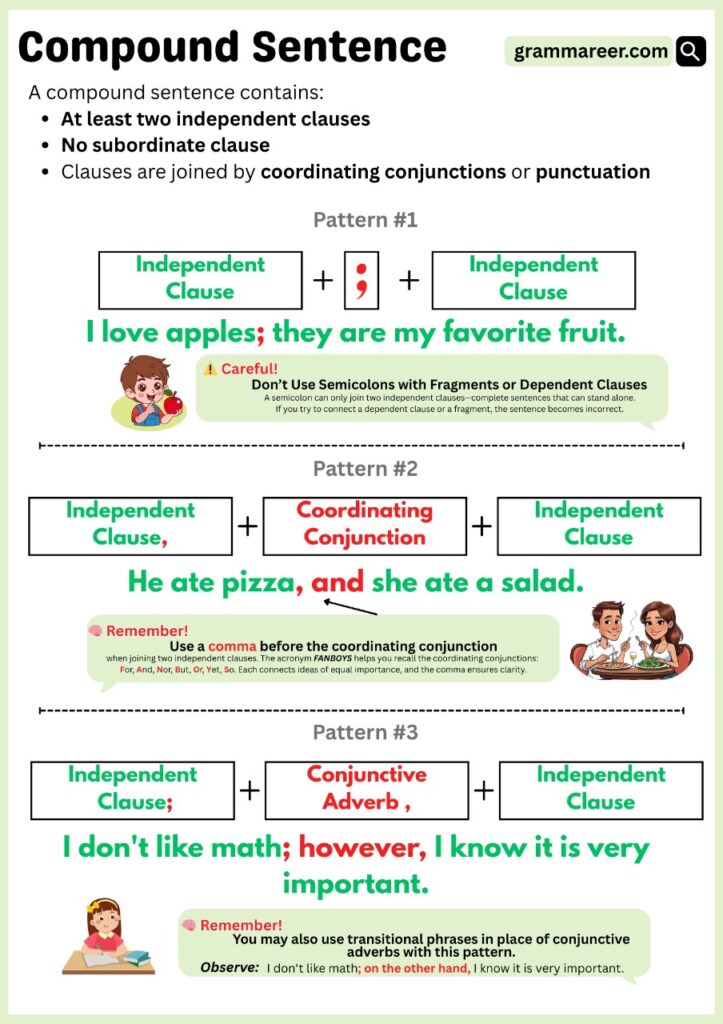
Rules to Keep in Mind When Forming Compound Sentences
When you create a compound sentence, you’ll need to link independent clauses using coordinating conjunctions—and don’t forget to check your punctuation. Here are a few key points to remember:
- First, compound sentences are simply two or more main clauses joined together. A main clause (or independent clause) is a complete thought that can stand on its own.
- Second, always place a comma before the coordinating conjunction that joins the clauses. The coordinating conjunctions you can use are for, and, nor, but, or, yet, and so.
- Sometimes, you can skip the conjunction and connect the clauses with a semicolon instead.
- When it comes to capitalisation, only the first word in the sentence needs a capital letter—unless you’re writing a proper noun.
- You can also use conjunctive adverbs like however, anyway, meanwhile, likewise, and otherwise. In this case, add a semicolon before the adverb and a comma after it.
One common mistake? Making compound sentences too long. Keep them short and clear so your ideas are easy to follow. Add extra clauses only when it’s truly necessary.
Compound Sentence Structure
A compound sentence is made by joining two or more independent clauses each with its own subject and verb into one smooth sentence. These clauses could stand alone, but when linked, they make your writing flow better and sound more complete. You can connect them using a comma with a conjunction, a semicolon, a colon, or even a dash exactly how we explained above.
Examples:
- She studied all night; she wanted to pass the test.
- He had one dream: to travel the world.
How to Use a Compound Sentence?
You can use different methods to join independent clauses and form a compound sentence. There are five main ways, and each has its own style and purpose.
1. With a comma and a conjunction (, and / , but / , so):
- I like spicy food, but my brother prefers mild flavors.
2. Semicolon:
- The sun was shining**;** the birds were singing.
3. Colon:
- He had one clear goal**:** to win the championship.
4. Dash:
- I was going to call you — then I remembered you were on vacation.
5. Semicolon + conjunction:
- She studied hard; and she passed the exam with flying colors.
Note that they form the handy mnemonic FANBOYS. The three you will use most often are ‘and,’ ‘but’ and ‘or.’
Examples of Compound Sentences
Now that you know what compound sentences are, let’s check out some simple examples. This will help you see exactly how to join two complete thoughts into one smooth sentence.
1. Compound Sentences with a Coordinating Conjunction:
- (Use and, but, or, so, yet, for, nor to connect ideas)
- I wanted to go for a walk, but it started raining.
- She baked a cake, and her sister made tea.
- You can take the bus, or we can walk there together.
2. Compound Sentences without a Conjunction:
- (Use a semicolon to join related ideas)
- I studied all night; the exam was really important to me.
- The shop was closed; we decided to try again tomorrow.
- My phone battery is low; I need to charge it soon.
3. Compound Sentences with a Conjunctive Adverb:
- (Use words like however, therefore, meanwhile, otherwise)
- I wanted to buy the jacket; however, it was too expensive.
- We left early; therefore, we avoided the traffic.
- She started cooking; meanwhile, I set the table.
Why Compound Sentences Are Important?
Compound sentences help join ideas and make writing flow better. Instead of short, broken sentences, they show how thoughts connect, like I wanted to go for a walk but it started raining.
They also make writing more interesting and easy to read. Using both simple and compound sentences makes your writing sound smooth and natural.
FAQs
It’s a sentence that joins two ideas that can stand alone, making your writing more complete.
Different dictionaries define it similarly: Cambridge calls it two independent sentences joined by and, or, or but; Macmillan says it’s two or more clauses linked by a coordinating conjunction; Collins describes it as two or more independent, coordinate clauses.
• Always have at least two independent clauses.
• Connect them with a coordinating conjunction or a conjunctive adverb.
• Use a comma before a coordinating conjunction.
• Use a semicolon before a conjunctive adverb.
• You can also skip the conjunction and just use a semicolon.
• I wanted to watch a movie, but my sister preferred reading.
• She baked a cake, and I made lemonade.
• We studied hard; therefore, we did well on the test.
• The sun set slowly; meanwhile, the birds sang their evening songs.
• He enjoys football; he never misses a game.
Final Thoughts
As we learned, compound sentences are a simple yet powerful way to join two complete thoughts to make your writing smoother and more natural. They help connect ideas clearly and make your writing more interesting and lively, giving your sentences a nice rhythm.
You May Also Like
What are Prepositional Phrases?
Descriptive Adjectives
What is a Predicate?

